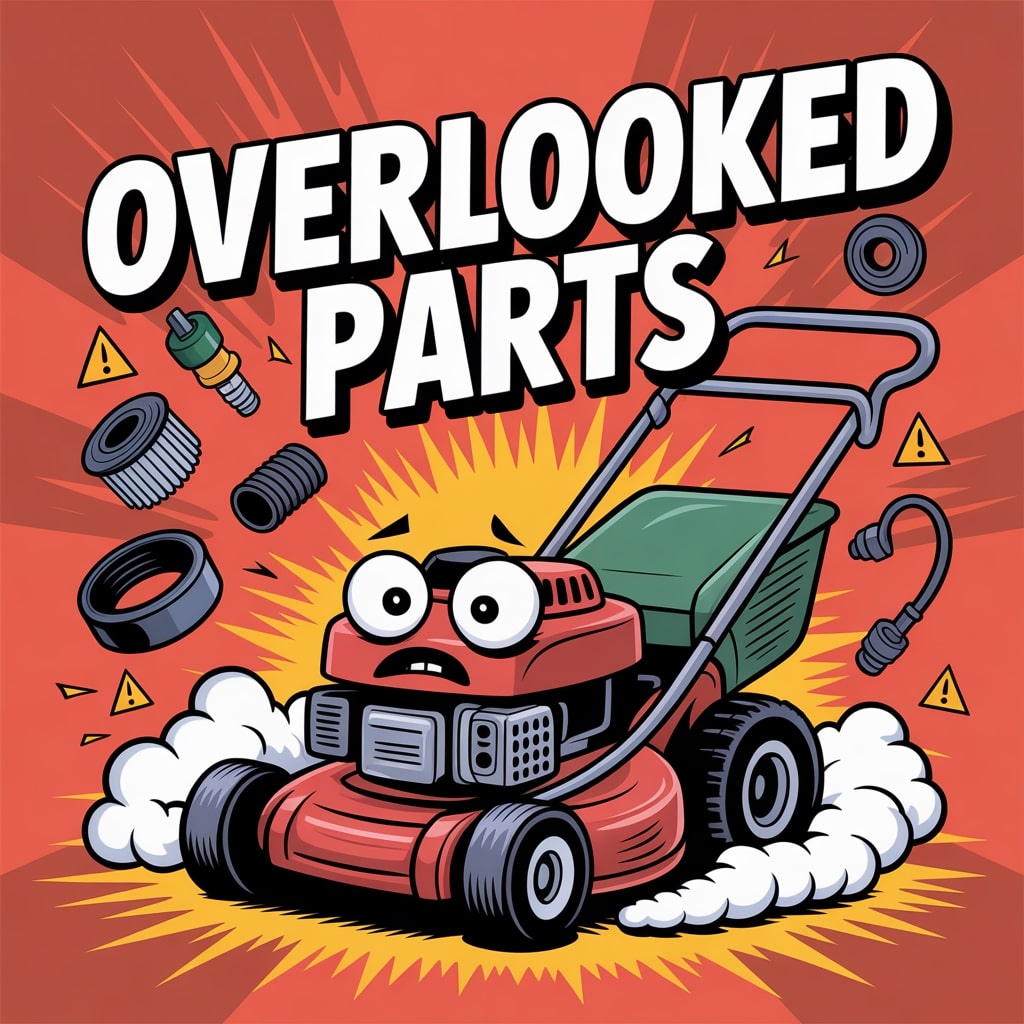
You ever notice how it’s never the big, obvious thing that ruins your Saturday? Nope. It’s always some tiny part — a spark plug, a fuel filter, a crusty battery terminal — throwing a fit and making your mower sound like it needs medical attention. I’ve seen folks replace half their mower trying to fix a simple throttle cable that got sticky… or spend hours blaming the carb when it was just a clogged air filter from one dusty job.
Happens every single week.
So before we get into the 10 small mower parts that cause the biggest headaches, let’s talk about why these tiny pieces matter way more than most homeowners think — and why ignoring a little thing can snowball into an expensive mess faster than you can say “why does my mower smell like burning rubber?”
And trust me — when a blade bolt loosens up or a drive belt stretches, your mower will complain louder than a teenager waking up early.
Alright, let’s start with the simple truth most folks overlook…
Why Small Mower Parts Matter More Than You Think
Here’s the deal: most mower breakdowns aren’t caused by “big failures.” They come from tiny pieces working overtime until they finally tap out. Little stuff — like a grimy air filter, a cracked fuel filter, a worn carburetor gasket, a slipping drive belt, or loose safety switches — those are the real troublemakers. And when one of these parts quits, it takes your whole Saturday with it.
Most people don’t think about these small parts until something goes wrong. But one weak link throws off everything. Fast check: if your mower starts surging up and down like it’s breathing through a straw, that’s usually a dirty fuel filter or a leaking carburetor gasket, not some huge engine disaster. Same thing with vibration — 9 out of 10 times it’s a loose blade bolt, not a cracked crankshaft like your neighbor swears it is.
I once had a guy swear his “engine was dying.” Turns out he just had a plugged air filter from mowing behind his gravel driveway. Five seconds tapping the dust out and the mower purred like nothing happened. Happens all the time.
And don’t get me started on battery terminals on riding mowers. One bit of corrosion and the thing will only go “click click click” like it’s mocking you. Quick trick: hit it with a wire brush and suddenly the mower cranks right up, like it got a shot of espresso.
Plus, these tiny parts are cheap — but ignoring them is not. A stretched drive belt? You lose self-propel and end up pushing the mower like it’s leg day. A worn throttle cable? Your engine will run with half the power and none of the manners. A flaky safety switch? Your mower won’t start and you’ll stare at it like it betrayed you.
And when one part goes, it drags everything else down. Dusty summers in the Midwest? That kills pulley bearings fast. Wet Northeast mornings? Moisture sneaks into safety switches and they start acting up. Southern heat? Thin oil + worn carb gaskets = surging engine. Southwest dust? That chews through air filters like crazy.
Point is: tiny parts matter. They matter a lot. And taking 30 seconds to check them saves your mower, your yard, and your patience.
Now that you get the “why,” let’s talk about the 10 small parts that cause the biggest headaches — and how to spot trouble before it turns into a “Hey Google, why does my mower sound like this?” moment.
10 Overlooked Mower Parts That Lead to Major Breakdowns
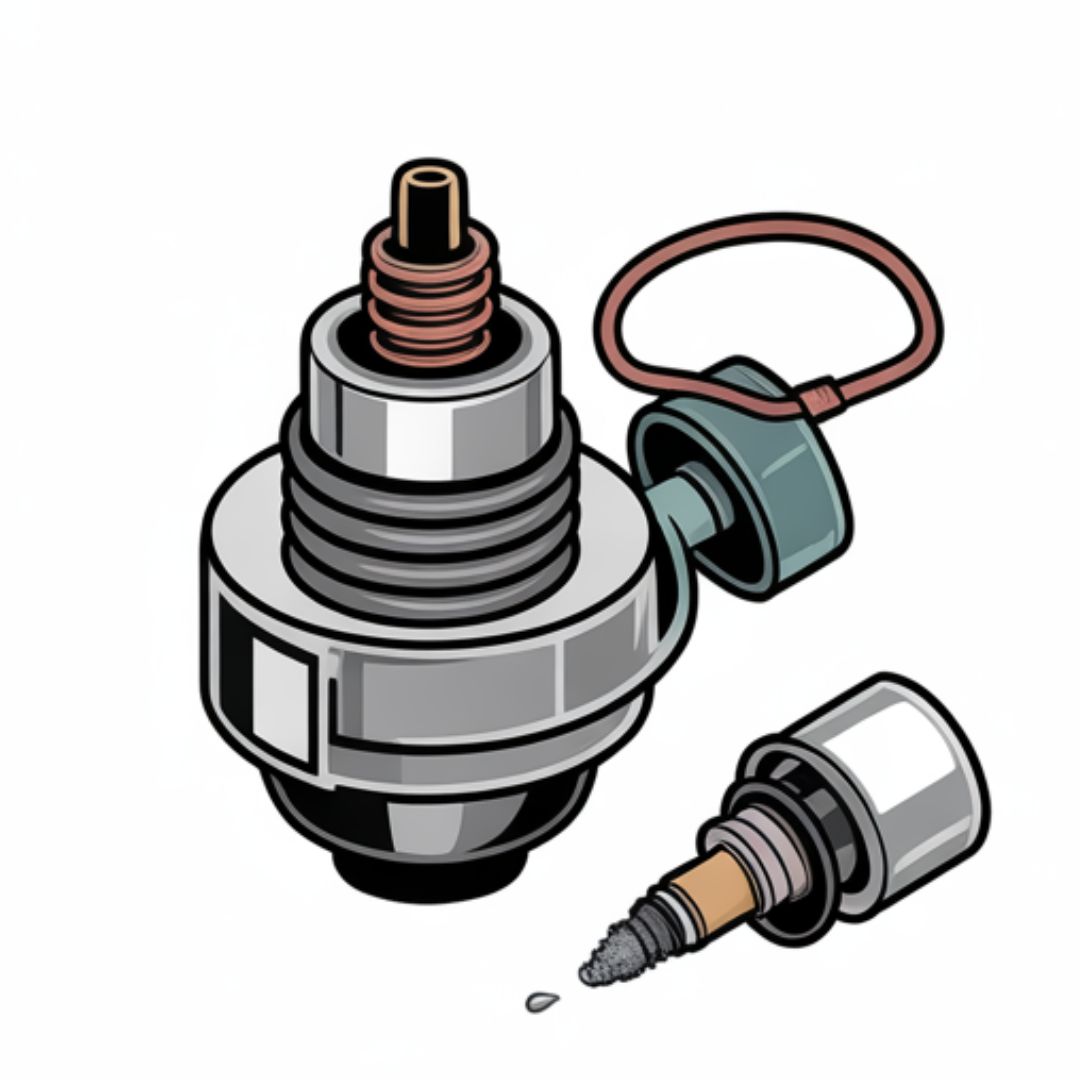
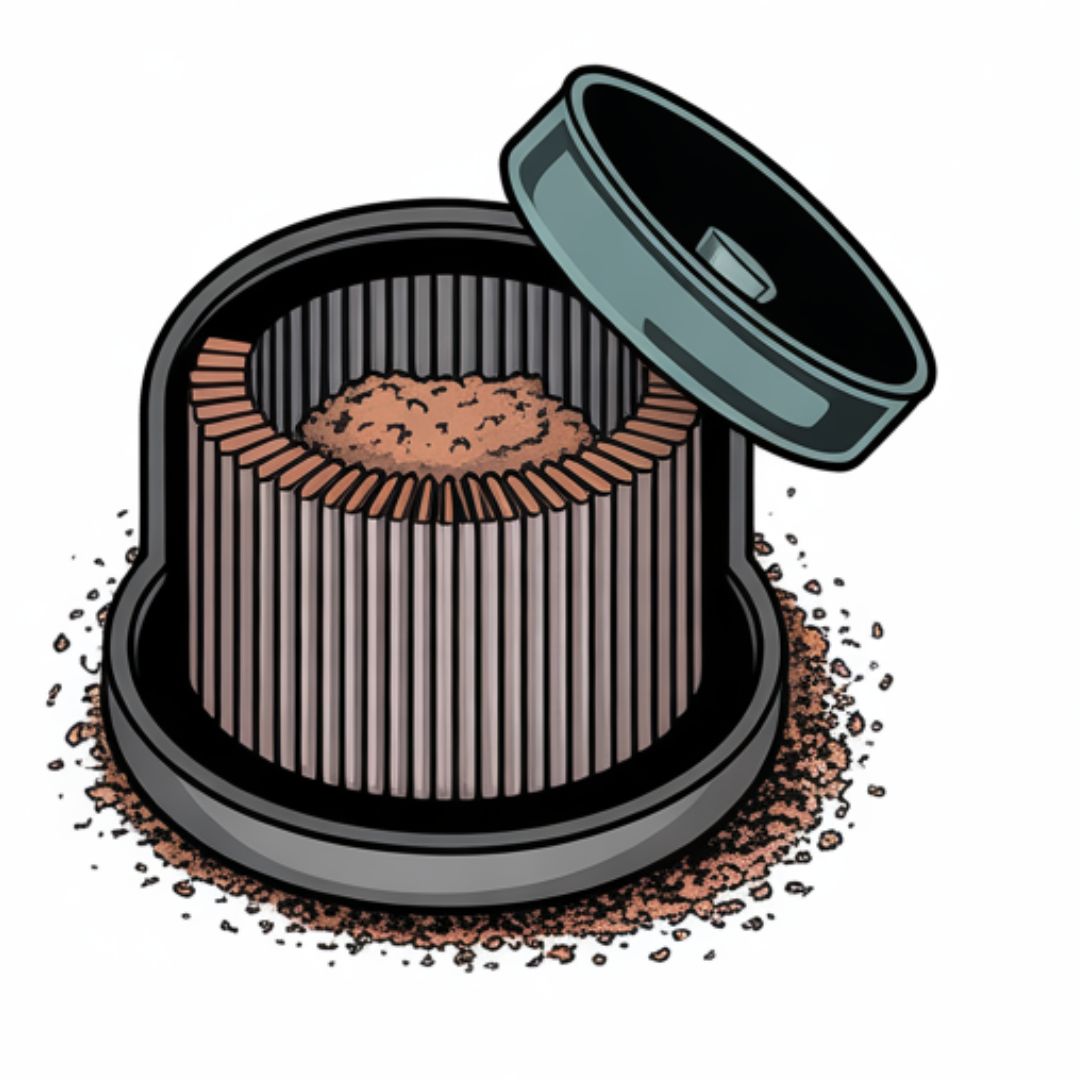
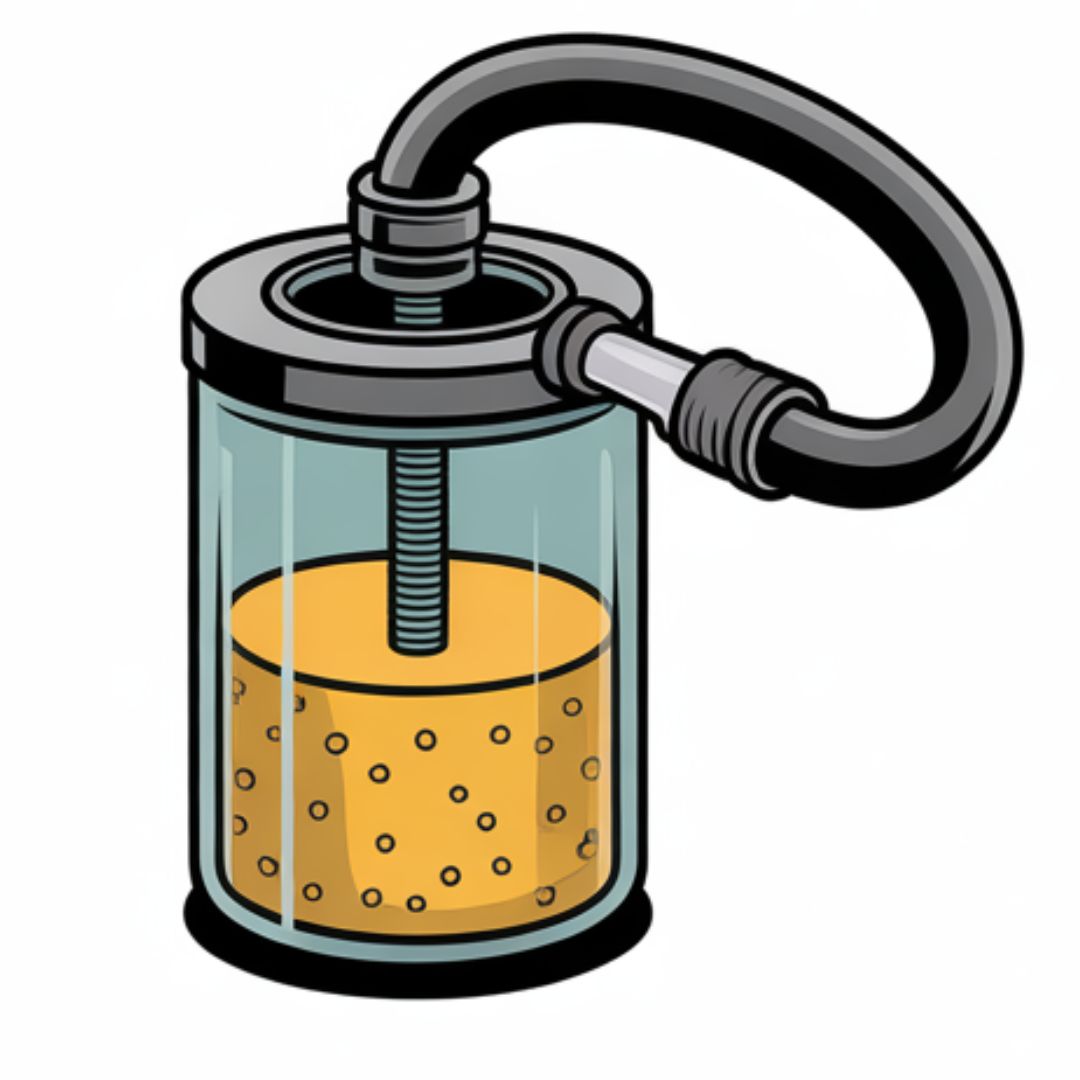

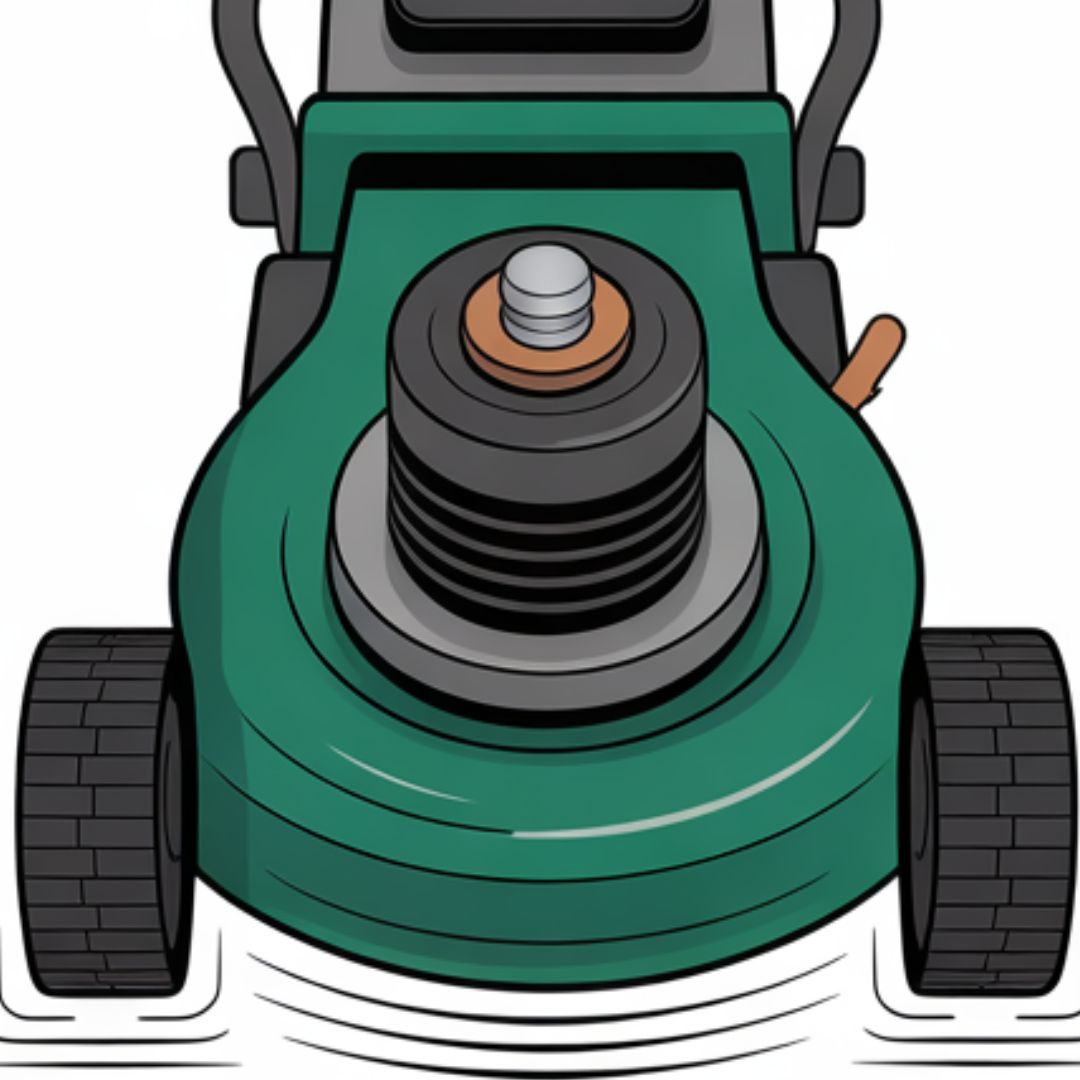
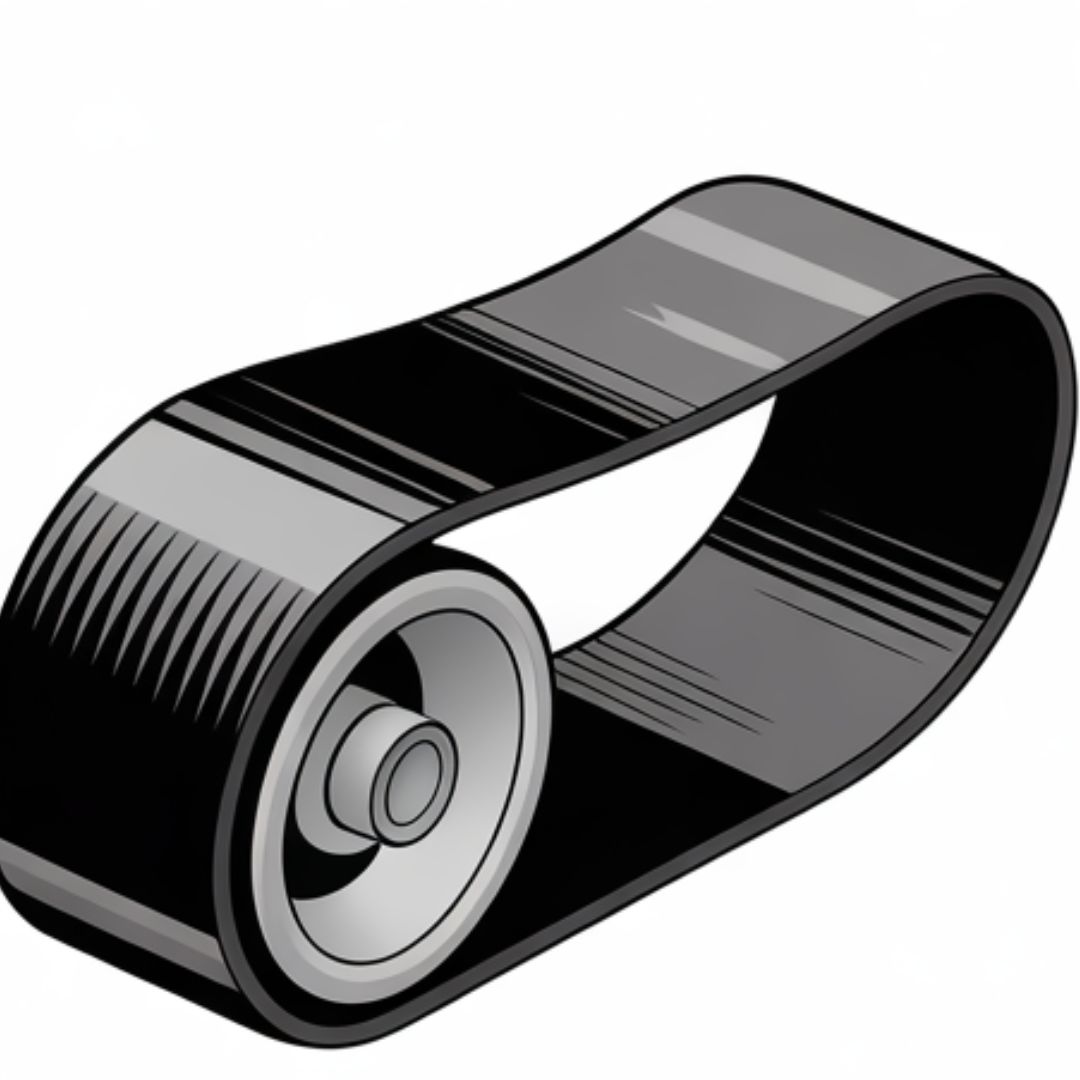
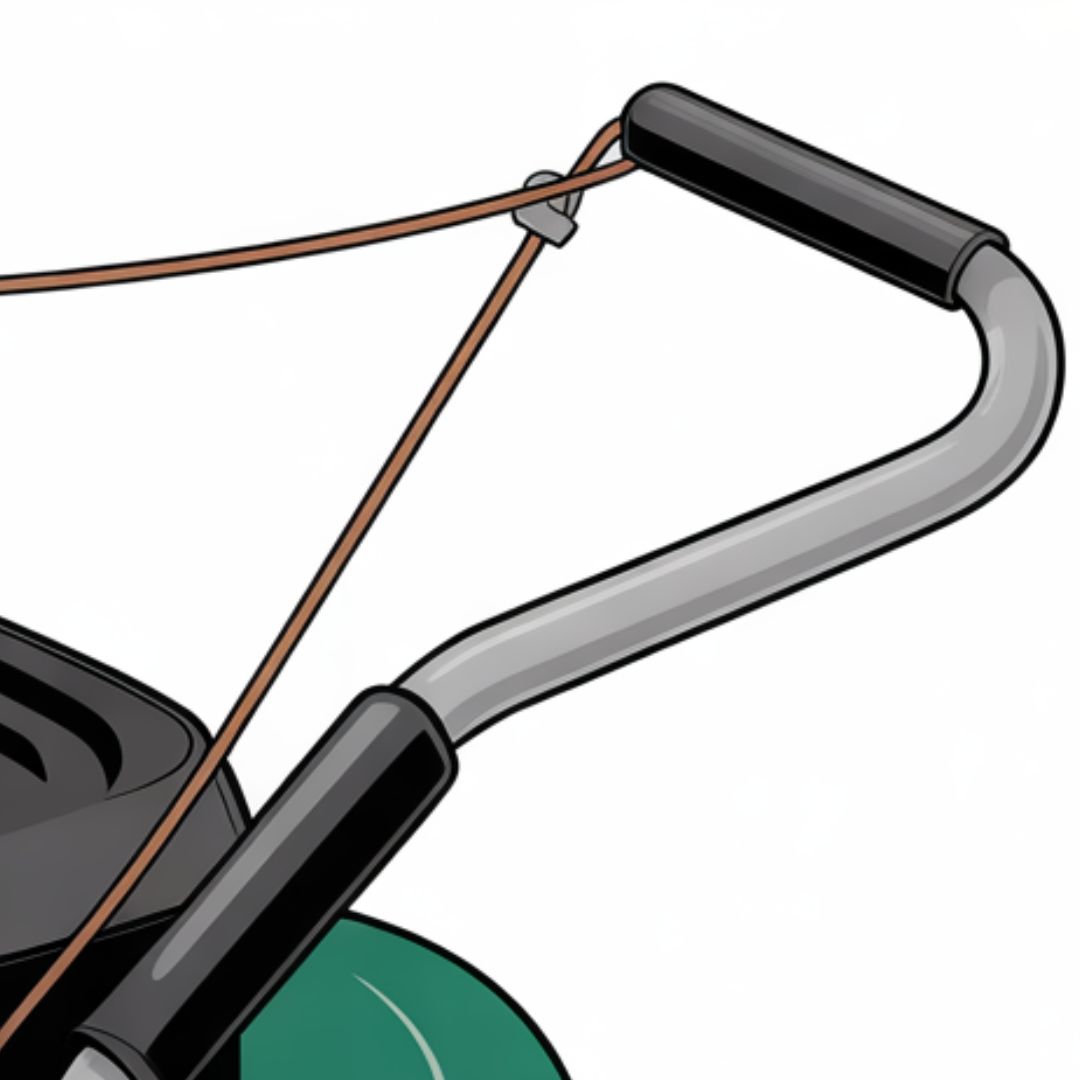
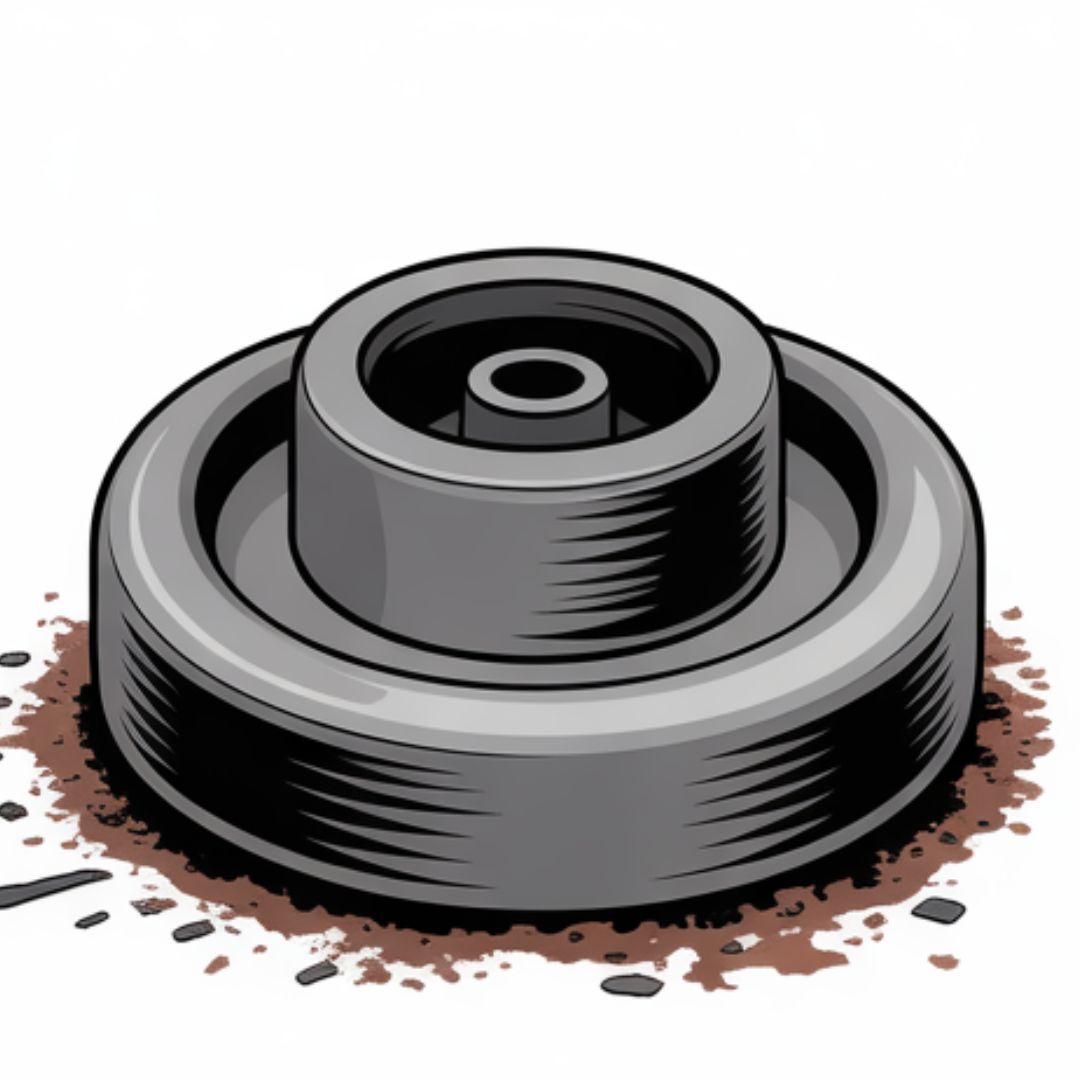
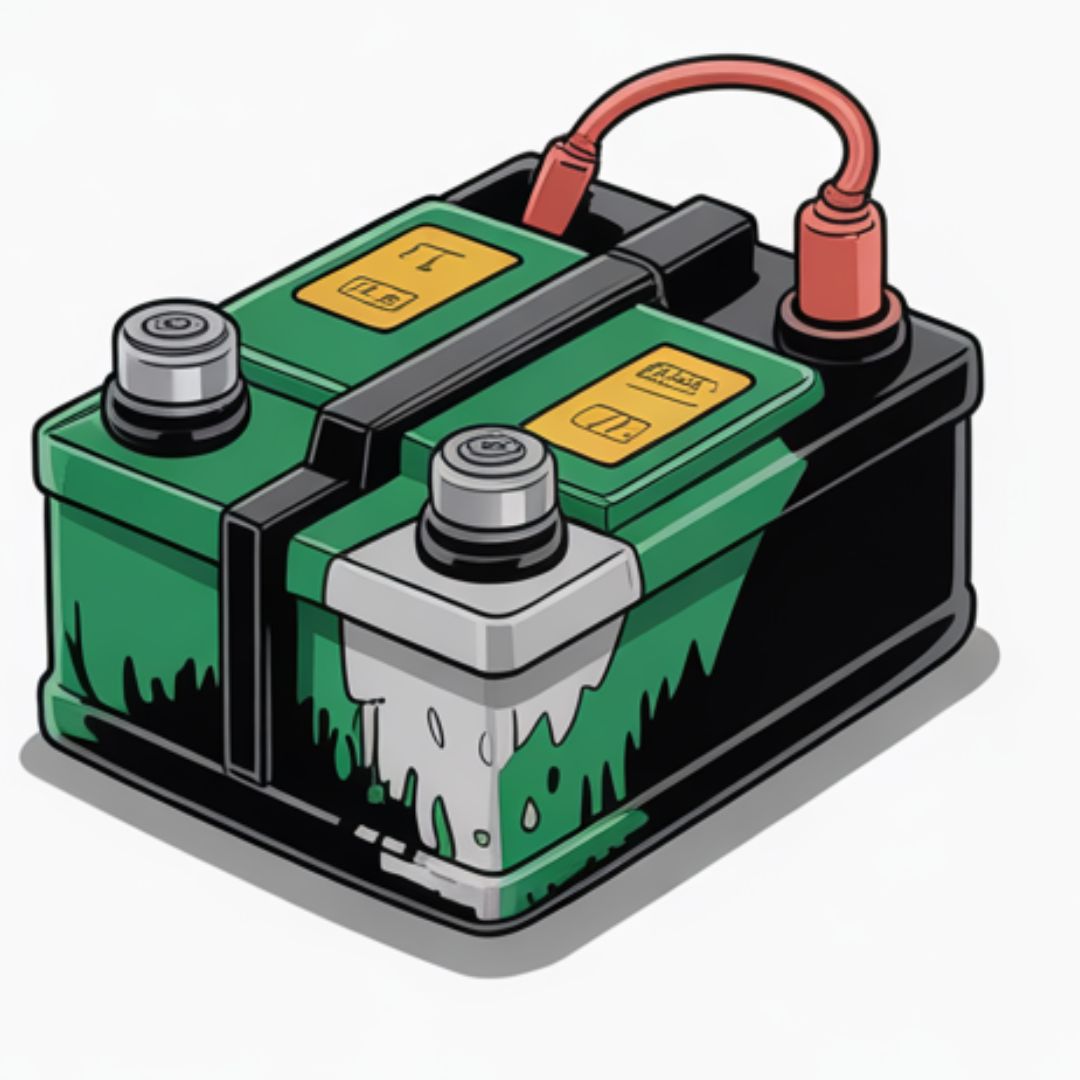
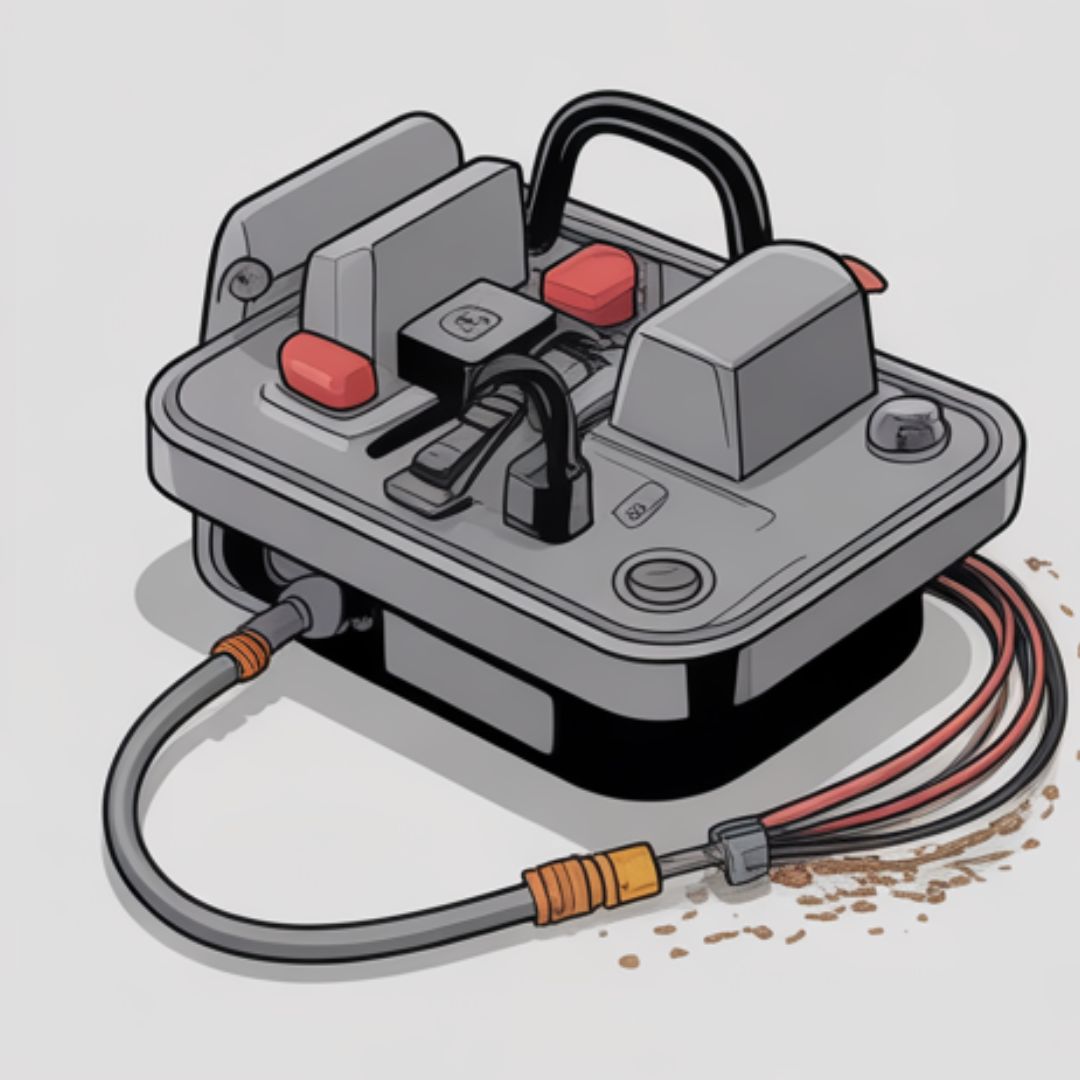
What Happens When These Parts Get Ignored
Ignoring little mower parts is like ignoring a weird noise in your truck—you can, but it won’t stay quiet for long. These tiny pieces might look harmless, but when they go bad, they create the kind of chain reaction that ruins lawns and weekends. Here’s what really happens when folks skip the small stuff:
Engine Surging
Symptoms: That choppy “vroooom… vroom… vroom…” rhythm.
Likely cause: Clogged fuel filter or leaking carb gasket starving the engine.
What’s happening: The mower is gasping for air or fuel.
Hard Starts
Common reasons: Dirty spark plug, weak plug wire contact, or crusty battery terminals.
Leads to endless cord-pulling — and a sore shoulder.
Loss of Power
Usual suspects: Plugged air filter, half-stuck throttle cable, failing pulley bearings creating drag.
Feels like the mower suddenly aged 20 years.
Violent Shaking
99% cause: Loose blade bolt or warped blade.
Your mower should never rattle like a paint shaker.
Self-Propel Not Working
Root cause: Worn drive belt.
Simple fix — annoying symptom.
Overheating
What causes it: Clogged cooling fins, blocked airflow, dirty air filter, or vacuum leaks.
Running hot is like mowing with a heatstroke.
Shredded Belts
Why it happens: Seized or misaligned pulley bearings chewing the belt.
Belt snaps like cheap licorice when this happens.
Random Shut-Offs
Top cause: Loose or failing safety switches.
They love to kill the engine at the worst possible time.
Uneven Cuts
Not always the blade itself.
Likely reason: Loose blade bolt or dragging belt making the deck tilt under load.
Most people underestimate how fast a cheap part can take out an expensive one. A $6 filter can destroy a $120 carb if you ignore it long enough. A $7 bolt can wreck the blade mount. A $4 gasket can cook your engine. It’s almost funny how predictable it is—except when it happens to you.
Quick tip: If something feels “off,” stop mowing. A weird vibration or a sudden loss of power is your mower’s way of begging you to check the small stuff first.
Now, before this turns into a full country song about broken mowers, let’s make things easier. Here are a few quick checks you can knock out in under a minute…
Quick Fixes: What You Can Check in Under 60 Seconds
Here’s the good news: most mower problems show themselves way before anything expensive breaks. You just need a few fast checks — nothing fancy, no toolbox explosion, no YouTube rabbit hole — just simple, “pop the hood and look” stuff any U.S. homeowner can do.
These are the quick wins that save your Saturday:
Lawn Mower Maintenance Checklist
Keep your mower running smoothly with these quick maintenance checks
These 10 tiny checks save time, money, and a whole lot of yelling at the mower. And honestly, most homeowners do none of them until it’s too late.
Gas vs. Electric: Which Small Parts Fail More Often?
Alright, let’s settle this real quick: both gas mowers and electric mowers have their own brand of drama. One isn’t magically “better” — they just break in different ways. Think of gas mowers like old pickup trucks and electrics like new SUVs: both get the job done, just different headaches.
Here’s the straight-up comparison you actually need:
| Small Part | Gas Mower Trouble | Electric Mower Trouble |
|---|---|---|
| Spark plug | The #1 no-start culprit. Gets dirty, loose, or moody. | Doesn’t exist. One less thing to blame. |
| Air filter | Clogs fast in dusty yards. Causes weak power & surging. | Nope. No filter. Battery mowers breathe easy. |
| Fuel filter | Loves to clog, especially with old gas. | Also doesn’t exist. |
| Carburetor gasket | Dries out, cracks, leaks, makes engine hunt like crazy. | No carb, no gasket, no drama. |
| Drive belt | Stretches, slips, kills self-propel. Common issue. | Some models have belts, but fail way less often. |
| Pulley bearings | Grinding, screeching, belt-eating little monsters. | Rare issue. Only on bigger or hybrid decks. |
| Throttle cable | Loves to stick or stretch. Big power thief. | Some electrics use electronic throttles — fewer issues. |
| Battery terminals | Only on riding mowers — corrosion city. | Yes, and these fail a lot from moisture or wear. |
| Safety switches | Fail when dusty or wet. | Fail when bumped, wet, or slightly misaligned. Equal pain. |
The Honest Breakdown
Gas mowers fail more from dirt, heat, and vibration.
Electric mowers fail more from battery and switch issues.
Real-life quick examples:
- If a gas mower surges, it’s usually the fuel filter or carburetor gasket.
- If an electric mower cuts out randomly, 9/10 it’s a flaky safety switch or worn battery terminals.
- If a gas mower shakes, check the blade bolt.
- If an electric mower shakes… congratulations, you definitely hit something.
Which type is easier for small-part fixes?
Gas mowers have more parts to babysit — but any lawn guy can fix them in minutes.
Electric mowers have fewer parts — but you deal with battery drama, charger drama, and electrical gremlins.
Either way, tiny parts run the show.
Now that you see how both types act up, let’s talk about how the weather and your region decide which parts fail faster. This part surprises a lot of folks…
U.S. Regional Breakdown: What Fails Most in Your Climate
Where you live has a huge impact on which small mower parts throw tantrums first. It’s not just luck — different climates beat up different parts. Ask any lawn pro who’s worked all over the country… you learn real fast what each region destroys.
Here’s the quick, no-nonsense breakdown:
Find Your Region’s Common Mower Failures
Northeast
(NY, PA, MA, NJ, VT, NH, ME)
What to expect:
Cold springs, wet mornings, thick turf.
What fails first:
- 🌬️Air filter — Wet grass clumps + spring pollen choke it fast.
- ⚡Safety switches — Moisture sneaks in and they get flaky.
- 🔩Blade bolt — Hitting hidden sticks and soft branches loosens it.
Real-life note:
Mow at 8 a.m. here and you’re basically mowing soup.
Midwest
(OH, MI, IL, WI, MN, IA)
What to expect:
Dusty summers, wild temperature swings, thick lawns.
Common fail points:
- ⚙️Pulley bearings — Dust gets inside and turns them crunchy.
- 🌬️Air filter — Gravel driveways + dry wind = instant clog.
- 🔗Drive belt — Heat + dust wears it down faster.
Neighbor moment:
I’ve seen midwestern mowers squeal so loud from bad bearings, you’d think they were haunted.
South
(TX, FL, GA, AL, SC, LA)
What to expect:
Heat, humidity, nonstop mowing season.
What gives out:
- 🔧Carburetor gasket — Heat dries them out and they leak.
- 🔗Drive belt — Stretches like old sweatpants in heat.
- 🔋Battery terminals — Humidity = corrosion city.
Quick tip:
If your mower surges in southern heat, check that gasket first. That’s the usual suspect.
Pacific Northwest
(WA, OR)
What to expect:
Moist, mossy, soft lawns. Almost always damp.
Frequent issues:
- ⚡Safety switches — Moisture = misfires.
- 🔩Blade bolt — Mossy lawns hide bumps, loosening the bolt.
- 🌬️Air filter — Gets musty and soggy, not dusty.
Local truth:
Your filter won’t fill with dirt… it just stays weirdly damp.
Southwest
(AZ, NM, NV, CA desert areas)
What to expect:
Dry dust storms, hot metal, brittle plastic.
Top failures:
- 🌬️Air filter — Dust destroys it faster than anywhere else.
- ⚙️Pulley bearings — Sand gets in and grinds them down.
- ⚡Spark plug — Extra carbon from hot running engines.
Fast check:
If you can write your name on your mower deck dust, clean the filter. It’s choking.
Mower Failure Prevention Guide
| Component | Warning Signs | Prevention Tips |
|---|---|---|
| Air Filter | Engine straining, reduced power, black smoke | Clean or replace every 25 hours of use |
| Pulley Bearings | Squealing or grinding noise, vibration | Keep clean, lubricate annually, replace when noisy |
| Carburetor Gasket | Engine surging, hard starting, fuel leaks | Inspect annually, replace if brittle or cracked |
| Drive Belt | Slipping, reduced cutting power, fraying | Check tension monthly, replace seasonally |
| Blade Bolt | Excessive vibration, blade wobbling | Tighten before each use, replace if damaged |
| Safety Switches | Engine won’t start, dies when engaging blades | Keep dry, clean contacts, test monthly |
Every region has its “usual troublemakers,” and once you know yours, mower maintenance gets about 10× easier. It’s not luck — it’s climate.
Alright, here’s the honest truth — most of the time, these tiny mower parts don’t just “go bad.” They’re pushed off a cliff by everyday habits most homeowners don’t even think about. No judgment — everybody does at least three of these. But if you want your mower to stop throwing tantrums, these are the things to stop doing.
- air filters (moisture + clumps)
- pulley bearings (rust from spray-up)
- drive belts (slip, squeal, stretch)
- Grinding = pulley bearings
- Screeching = drive belt
- Rattling = blade bolt
- air filters
- throttle cables
- pulley bearings
FAQs
What small parts fail the most?
The small stuff: spark plug, air filter, fuel filter, carb gasket.
Also belts, pulley bearings, and safety switches.
These tiny parts take a beating every mow.
Why does my mower vibrate?
Loose blade bolt, bent blade, or bad pulley bearing.
Tighten the bolt and spin pulleys — if one grinds, replace it.
The engine is rarely the reason.
Why does my mower surge up & down?
Clogged fuel filter, dirty air filter, or leaking carb gasket.
The engine panics because fuel or air flow isn’t steady.
Fresh gas + new filter usually fixes it.
Cheapest part that causes big issues?
The $4 spark plug — it can shut the whole mower down.
Fuel filter is second place: surging, stalling, hard starts.
Both take under a minute to swap.
How often replace small parts?
Spark plug: once a season
Air filter: clean often, replace when dusty
Fuel filter: yearly
Drive belt: 2–3 years
Pulley bearings: when noisy
Carb gasket: when surging won’t quit
Throttle cable: when stretched
Safety switches: when inconsistent
All cheap. All worth it.
What should I inspect before every mow?
• Wiggle spark plug wire
• Tap air filter clean
• Check fuel filter for drips
• Ensure blade bolt is tight
• Spin pulleys for smoothness
• Check drive belt tension
• Test safety switches
• Wiggle battery terminals (riders)
Takes a minute. Saves a headache.
Conclusion
At the end of the day, it’s always the little pieces that decide whether your mower behaves… or acts like it’s filing for retirement. A loose blade bolt, a dusty air filter, a grumpy spark plug, or a stretched drive belt can make a perfectly good mower run like junk. And it’s never dramatic at first — it’s the tiny hints: a weird rattle, a little surge, a soft idle, a slow self-propel. Ignore those long enough, and these cheap parts turn into big, expensive problems.
The good news? Every issue on this list is something a regular homeowner can catch early. No fancy skills. No toolbox explosion. Just quick checks, fresh gas, and paying attention when something “feels off.” That’s all most mowers ever wanted.
Take a minute before each mow to look at the small stuff. Snap the spark plug tight. Tap the air filter clean. Check the fuel filter. Give the drive belt a squeeze. Spin the pulley bearings. Wiggle the battery terminals if you’ve got a rider. And always, always listen for new noises — the mower tells on itself faster than you think.
Do that, and your yard days get smoother, your mower lasts longer, and you avoid those “why is this happening right now?” moments in the middle of the summer heat. Little parts, big payoff.

I’m David man behind Lawn Mowerly; I’ve been dealing with lawnmowers and Tractors with my father since I was a kid. I know every make and model and what each one is capable of and love helping people find the perfect equipment for their needs.
